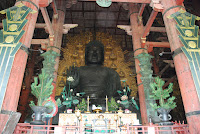 |
| Todai-ji Temple |
 |
| The Great Buddha |
For visitors to Japan, Nara contains a very nice slice of the land of the rising sun. Not so famous like Kyoto, Tokyo, Hiroshima or Osaka - Nara is known for its historical importance, the Great Buddha site, and last but not the least the sake (rice wine). It was the first permanent capital of Japan (before Kyoto and Tokyo) and is located near Kyoto and Osaka (takes less than an hour to reach there).
The main attraction of Nara is the todai-ji temple, which houses the great Buddha statue (the Diabutsu) which was created out of iron. All the non-samurai had to give up their swords to help create this huge statue of Buddha, amazing huh! According to the lonely travel guide book, this rivals Mt. Fuji and Kyoto’s golden pavilion as the single most impressive sight of Japan! Also, the Todai-ji temple is the largest wooden building in the world.
 |
| Sake barrels |
You will also come across free roaming deer walking all over the city. Sometimes they get aggressive but that is only when they see food. You can feed rice cakes (from local vendors) to them, just be a little careful as they would almost knock you over to get the rice cakes. One good thing, the ones with antlers have them filed.
 |
| Touka-e Festival in Nara |
We stayed late to watch the elegant summer night illumination events (in Japanese Touka-e festival). Since its beginning in 1999, it has attracted a large number of tourists and converted them into ardent fan of Nara. It is a fascinating sight, more than 20,000 candles illuminate Nara's famous world heritage sites. Each candle is set in a small plastic cup, and lit by hand, one by one.
Finally, sake. If you come to Nara, dont forget to try the sake. The history of Japanese sake started in Nara, and since then Nara has been producing the finest sake in Japan, indeed!



